The Irish offense finished 2023 ranked 14th in Offensive F+, which feels like a “meets expectations” grade from where things stood in the preseason. Still, the game-by-game output that placed Notre Dame there feels underwhelming – Sam Hartman and company throttled some inferior opponents but struggled to put points on the board in most of the season’s biggest games.
Now the offense has been given a complete makeover – upgrading Gerad Parker for Mike Denbrock, bringing in Riley Leonard as a dangerous dual-threat QB, overhauling the wide receiver room via the transfer portal, and a massive youth movement on the offensive line. Despite the lack of continuity, most projections still have the ND offense somewhere between 10th-20th nationally. Let’s break down what’s fueling that optimism and upside as well as the places things could fall apart this fall.
The Notre Dame Running Game
2023 was a peak year for the Irish running game. Audric Estime, star tackles leading a veteran OL, and a dangerous enough passing attack combined for an extremely reliable attack on the ground. Notre Dame was both efficient and explosive, finishing nationally 4th in expected points added (EPA) per rush.

Against the softer defenses on the schedule, Estime and the stable of replacements feasted. Only Duke truly held the rushing offense to an inefficient game on the ground – and a few explosive runs ultimately bailed out the offense and salvaged that win with the ND receiving corps decimated.
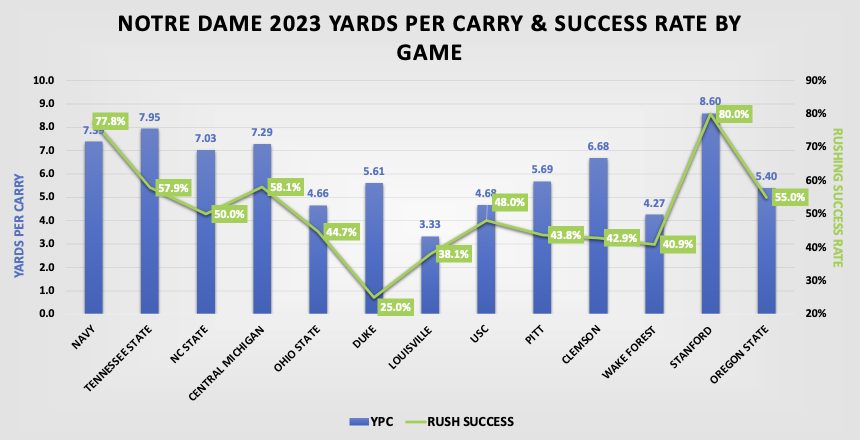
The biggest critique on this strong unit is that it wasn’t dominant against the tougher defenses on the schedule. Against Ohio State the Irish ground out a pretty efficient performance but struggled in short yardage and couldn’t find explosive runs. With the entire team looking worn down at Louisville the offensive line was in disarray and struggled to bail out the sputtering aerial attack. At Clemson some initial success on the ground faded and then some late Hartman scrambles inflate the overall numbers. There was no 2022 Clemson performance where the Irish could impose their will on a solid opposing defense (admittedly a high bar, but disappointing).
What will 2024 bring?
With so few returning key pieces, it’s hard to know what to expect for the 2024 rushing attack. The elephant in the room is the offensive line, which was already set for a step back before Charles Jagusah’s season-ending injury. The lines’ inexperience doesn’t mean the rushing attack will fall off a cliff, but it makes significant regression in efficiency (including stuffs allowed) very likely. Joe Rudolph and Mike Denbrock’s primary job will be mitigating that drop-off, and seeking ways to offset it with explosiveness.

Estime was spectacular in 2023, but Jeremiyah Love and Jadarian Price provide a high floor as they take on higher volume this fall. Neither were quite as efficient as Estime, but both flashed explosive traits both on tape and by the numbers. Surprisingly for a true freshman, Love was less boom or bust than Price – better avoiding negative plays but breaking long runs less frequently.
Price’s advanced numbers are very encouraging, with an explosive rate rivaling Estime and yards after contact and missed tackle rates in the same ballpark. His high stuff rate I’d judge as slightly random and inflated thanks to situational usage – but it’s something to monitor moving into the fall.
Payne will be missed as another experienced option with a clear role, but his numbers from carries last year show a clear drop-off versus the other backs. His short-down usage was a little puzzling given his performance converting those runs was just ok – in very small samples, Love and Price (plus Leonard) should comfortably take on that role.
Depth is the real concern for the running back room – true freshmen Aneyas Williams and Kedren Young will both see the field and are very close to being relied on in meaningful moments. Both appear physically ready and have positive practice buzz, but have the usual first-year hurdles to clear understanding the offense, blocking, and more.

The biggest reason for optimism is the addition of Riley Leonard’s legs. At Duke he was arguably the second best rushing QB the past two years among power conference QBs (trailing only Jayden Daniels). Stacked against the most successful recent dual-threats for the Irish, he still stands apart. Leonard adds an immediate element of explosiveness and efficiency when things get bogged down, and avoids negative plays. He should make life easier in the red zone and short yardage, and has terrific feet and balance (check out the yards after contact and missed tackle rate!).
Riley Leonard might be the most underrated quarterback in college football
An athletic playmaker at 6’4 205 with next level throw capability and rushing upside
Leonard’s one of my favorite sleepers to rise in the 2024 QB class
pic.twitter.com/1YRuD8LqWq— Joe O’Leary (@TheHQNerd) April 2, 2023
Projecting the ceiling and floor
Can Leonard and the talented young running backs overcome the expected drop-off from the offensive line? Probably not – I anticipate a big decline in Notre Dame’s rushing efficiency this year. Offsetting this with a bump in explosiveness is the best bet the Irish have for a winning formula on the ground.
The best-case scenario is probably a rushing attack that’s something like 2018, where the Irish had many negative rushing plays and struggled to find consistent efficiency but overcame those issues with Dexter Williams’ (and to a lesser extent, Ian Book’s) explosiveness and a complementary passing attack. In this ideal world Mike Denbrock is mitigating the line’s issues as the group matures, and the new faces perform better than expected. With a schedule that should only feature 4-5 close games, Notre Dame can lean heavily on Leonard to find success in those games against the toughest defenses and preserve his legs and health in the others.
Most likely, though? The running game will find success against the middle and bottom parts of the schedule but struggle in big games – something that’s been an issue even for the best Irish OLs in recent memory against the toughest defenses. Can the run game make enough critical plays – either breaking off a long gain or two, or converting power run situations – to be enough? A top 20-30 unit seems like a solid base case.
The worst-case scenario is that there’s so many issues with blocking that the entire offense is undermined – think the first half of 2021. This is unlikely with Leonard taking the place of Jack Coan, but the end result could be similar – the offense struggles enough that some games that shouldn’t be close suddenly are single-possession games where anything could happen. In this world the Notre Dame rushing attack is reliant on explosive plays and the rushing game has so many negative plays and lapses that it frequently kills drives by putting the offense in passing downs.
The Notre Dame Passing Game
The 2023 passing attack looks incredible in a spreadsheet. Zooming out, the Drew Pyne to Sam Hartman upgrade worked as expected, boosting production across the board to levels the Irish offense hadn’t seen in year. The passing game was efficient, explosive, and avoided negative plays.

Once you look deeper, though, you can see some of the feast-or-famine performances that lead to the gaudy season-long numbers. Hartman and company destroyed the lower-tier competition with six games averaging over 10 yards per pass play including the Sun Bowl win. But like with the running game, against top defenses things bogged down significantly, with below average efficiency against NC State (saved by explosive plays), Duke (explosiveness also rescuing things), USC (masked by the defensive masterclass), and the losses to Louisville and Clemson that highlighted Hartman’s big-game struggles.
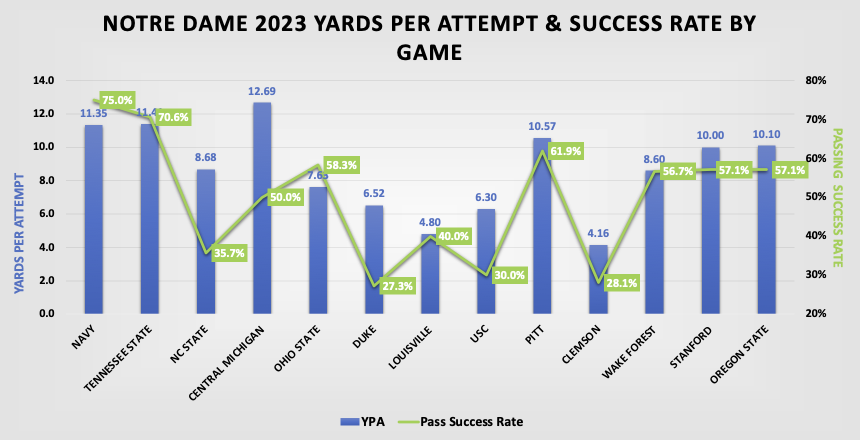
Ohio State was an outlier – the passing game shined early on but wasn’t explosive enough to translate into consistent points, leading drives to fizzle out. As the game progressed, the offense leaned more on the rushing attack (64% early down run rate) and there were so few possessions and drives for the strong passing performance to feel as impactful.
An overhauled receiver room
Of course, these game by game numbers gloss over a lot of context. By the Duke and Louisville games the wide receiver room was down to only four healthy scholarship players. The lack of a true WR1 limited the passing game – Mitchell Evans stepped into that void as the top receiving threat, but the Irish offense went through the critical six game stretch of the season (Ohio State – Clemson) with just one game where a wide receiver caught more than three passes (Chris Tyree 4-29 at Clemson).
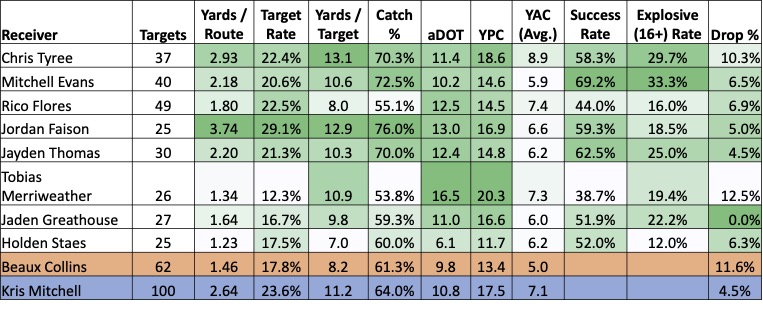
It’s fascinating to break down the numbers of the 2023 receivers when targeted because of how even targets were distributed – 8 receivers and tight ends had 25 targets, with just one player (Rico Flores) over 40. We can’t go too far comparing these numbers since there is so much the receivers don’t control – like when they are targeted and how accurate those targets are. But to see the production on a per route or per target basis can still help us see who did more when the offense threw the ball their way.
The departures: On paper, there’s a lot of lost volume with the transfers of Chris Tyree, Rico Flores, Tobias Merriweather, and Holden Staes. Tyree stands out among those losses as one of the most explosive and productive receivers when targeted – but it’s important to recognize how little production we are working with across this entire group. Tyree was the most productive wide receiver and yet his average box score output was 2.2 catches and 40.3 yards per game. Those snaps moving to some combination of Jaden Greathouse, Jordan Faison, and Jayden Harrison in the slot provides similar explosive upside with more versatility and youth.
Flores and Merriweather sting less simply because they struggled with production even with solid QB play from Hartman. Both were probably relied upon too much (especially Flores being counted on to play a major role as a true freshman), but were still some of the least efficient receiving options when targeted.
Returning upside: Mitchell Evans unexpectedly stepped into the role as Notre Dame’s most reliable receiving threat, and shined in big games with a significant volume of targets. His health will be a lingering question, but he should again be a major asset that brings an invaluable combination of efficiency and explosiveness to the passing attack. It’s not a fair comparison with Hartman vs. Drew Pyne delivering passes and the incredible volume his predecessor took on, but his per snap and per target metrics compare favorably with Michael Mayer’s.
I don’t think you can make much of Jayden Thomas and Jaden Greathouse’s production last year. Both were hampered by injuries and likely pushed back into time before back to 100%. At this point, we know who Thomas is when he’s healthy – a reliable, efficient option who can be productive in a supporting role. He may be schemed into explosive plays but isn’t likely to hit home runs (although he has slimmed down this offseason).
Greathouse is a wild card as the spring and fall buzz have positioned him as the potential WR1 (while recognizing there’s probably no one dominant receiver). That type of sophomore leap is definitely possible with his pedigree and a well-rounded skillset, and it feels like the staff is setting Greathouse up for success with the bulk of slot receiver snaps.
That means more reps for the final member of this group, Jordan Faison, out wide. And whew, Faison’s numbers from his freshman season are impressive in a small sample. He boasts a ton of explosive upside both as a deep ball threat as well as a dangerous YAC option in the screen and short passing game.
yesterday’s post route run by @NDlacrosse freshman Jordan Faison was no different than a split dodge taking topside out of the box — make no mistake, the best dodgers in lacrosse can take care of anyone. pic.twitter.com/HZdm3ksaXA
— Paul Rabil (@PaulRabil) November 26, 2023
It’s been a long time since the Irish have had a traditional WR development success story with steady progress each year (maybe since Chase Claypool?). The last few candidates with flashy freshman seasons (Lorenzo Styles, Braden Lenzy, and more) have seen setbacks due to injury, big-picture passing game struggles, and other setbacks. But Faison and Greathouse offer a chance for Notre Dame to set a strong foundation at the position for the next few years.
The transfers: Last but certainly not least, Beaux Collins and Kris Mitchell come into a wide open receiver room to boost the quality depth – ultimately raising the floor and ceiling. While both were likely attracted by the playing time and high profile opportunity in South Bend to boost their pro prospects, their incoming stories are almost polar opposites.
Mitchell comes in from FIU having proven his bona fides as a top receiving option with high volume – just at a lower level of competition. His numbers are fairly well rounded, but he profiles as more of an explosive threat than many of Notre Dame’s other outside receiving options. Will the G5 to P4 transition be seamless, or will he be more of a role player? The ceiling feels as high as WR1 in this offense with a floor where he’s firmly in the 5th or 6th option out of the rotation.
Collins has very different questions to address. His Clemson pedigree assures the quality of competition adjustment won’t be an issue. But the veteran struggled to produce consistently and efficiently within the shaky Tiger offense. There’s not a lot to love about his statistical profile with some drop questions and very little yard after the catch ability.
However! The fall camp buzz has been overwhelmingly positive about Collins physically impressing and filling an area of high unmet need at the boundary receiver. Film guys far smarter than me have made a strong argument that Collins was mis-used at Clemson in a passing offense that flopped.
The OL elephant in the room
This is normally the section where I’d pull in a lot of offensive line stats from the past few years, do a little depth chart run down, and make some predictions. But I’m not sure it’s all that helpful! The line was very good last year – preventing sacks and negative plays in general, and enabling extremely high efficiency in the rushing game.
But with four new starters, there’s really no data to go off of here. It’s an outstanding question that will simply need to be monitored throughout the season. Horrible offensive line play – like in the beginning of 2021 for Notre Dame, or the late Jimbo Fisher era at FSU- can absolutely tank an entire offense, even with solid QB and skill position talent. However, I don’t think the floor is likely to totally fall out on this group – there’s too much pedigree with blue chip talent and with the exception of Anthonie Knapp, a lot of guys stepping into roles that have won battles and seem prepared to step into greater roles.
What’s clear is that the Irish will need every ounce of Mike Denbrock’s experience to mitigate the offensive line as the weak link in this unit (and really the team as a whole). Especially against the best defenses on the schedule, there’s several different approaches as options – will he employ tons of screens, play-action, and roll-outs for Leonard to slow down opposing pass rushes? Will he be fairly conservative on early downs and 3rd and longs, knowing the nasty ND defense means he shouldn’t need to press? Or if the efficiency to sustain long drives isn’t there, will he look to scheme up a few calculated explosive shots to manufacture enough points to get the job done?
Predictions and Probabilities
Notre Dame’s projected F+ rating (11th nationally) feels ambitious – for me more like a ceiling case than the likely outcome. I’d bet this is the driver in the difference you see between SP+ and FEI projections and the early points spreads for ND’s biggest games (for example, the Irish favored in College Station versus something like a 3-point underdog). Vegas has downgraded the ND offense a bit more than the projection systems – which just look at enough returning pieces from an offense power-rated 14th last season to feel more confident.
I’d bet on the Irish finishing closer to 20th in F+ – buoyed by strong performances against weaker defenses but struggling for long stretches in the matchups with Texas A&M, Louisville, and FSU. The ideal formula feels like a fairly efficient but very explosive rushing game that’s the backbone of the offense, complemented by an efficient passing game (with some explosive upside). I’m a little skeptical of the wide receiver situation being a true strength in the critical games on the schedule – yes, depth issues have been addressed, but I’m wary of who the offense can rely on to get open outside of a recovering Mitchell Evans. No true WR1 (and the time it may take to figure out the best allocation of snaps with some duplicative strengths in the slot) is a red flag.
I don’t think there’s man likely outcomes where the bottom falls out offensively, but it would look something like this: the offensive line struggles all year, Leonard gets banged up early, and the skill position talent underachieves expectations and can’t compensate for the line woes. These issues pop up in the big games on the schedule and put some of the middle tier games of the schedule at risk.
The best news here will come in the defensive deep dive. There’s a formula where even a 20th best offense and top-5 defense still adds up to a top 5-10 quality team – which against Notre Dame’s cushy schedule in 2024, should definitely make the playoff.


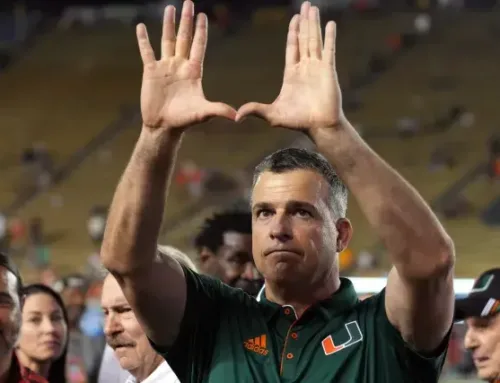
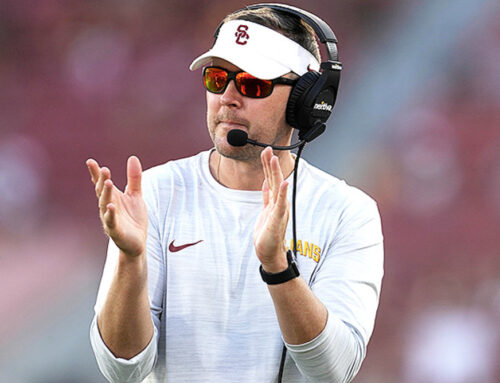
A big benefit to offset some of the offensive risks this year will be the experience and adaptable of denbrock.
Parkers game by game offensive results above scream that he didn’t adapt when at a talent parity or disadvantage. And we could see that in game too; notre dame didn’t check into runs vs 2 high safety (louisville) or pass against heavy boxes (clemson). This didn’t matter against a central michigan, our X’s were so much bigger than their O’s. But in the got to have it games, he didnt help the offense with play calls.
I think he’s much more demanding in execution of the offense compares to parker as well. Jamie uyemyama(?)was tweeting how awful their offensive execution was in particular against clemson. Threw a quick screen to a trips receiver against 2 off ball defenders for a…. 2 yard loss. Denbrock has the age and confidence to be much more forceful in demanding they do things right. Already, post practice interviews come across that way.
At the end of the day talent still trumps, but I feel like the offense was playing prime time games with one arm tied behind their back last season. I’m buying stock in the denbrock-effect.
Me too. Look at 2004 notre dame. What were the metrics saying about notre dame in 2005?. Did they predict samardijizza or stovall or quinns numbers. I doubt it. Something to be said for a quality offensive game plan That takes advantage of your skill sets
There aren’t many “metrics” from the 2004-2005 offseason still extant on the internet, but here’s one — the final Sagarin ratings from the 2004 season ranked ND #31. We were the highest-ranked 6-win team, and if you took those rankings and applied them to our 2005 schedule, you’d expect a record of 8-3. We went 9-2.
Man. This didn’t make me feel great. For me, on this schedule, anything but 12-0 or 11-1 where the loss was double OT with poor officiating on the road, would be soooo deflating. But I guess the defense being the backbone is a positive as long as they are top 5ish. Good, thorough article though.
Also, how did clemsom get by with such average offense lone recruiting hauls. I was looking at their stars from 2010 to 2020- not great. Why can’t notre dame replicate that?
I think the answer to your last question is Tajh Boyd, Deshaun Watson, and Trevor Lawrence.
100%
Also, Lawrence won the title as a freshman with Etienne being a total stud, and they ran a legit starting NFL defensive line. 3 first rounders and a 4th if im not mistaken.
So you’re saying there’s a blue print?
Yeah, you can — or could, under the BCS/4-team playoff — win a national title even if your recruiting classes are ranked in the teens if almost all those players turn out to be NFL starters and play like it from the time they set foot on campus.
Holy shit that FSU-GT game was awesome. Just everything we love about CFB. Two quick thoughts:
– I’m now more worried about GT than FSU.
– Sheamus was the only Gameday host that picked GT in this game, and he also picked ND to win the natty.
Tech in the Benz Dome could be a very, very fun game!
DJU’s game against us in 2020 feels like it was several lifetimes ago and yet that was probably the best game of his entire career.
Hey there’s that same FSU program that rage quit the postseason!
Interesting call to go for 2 on your first score in the first quarter, turns out to be the right call.
I believe Oregon under Helfrich and maybe late Kelly did it regularly. If I remember right, the numbers work out to it being the ‘right’ move
Depends on what numbers you’re looking at. Doesn’t seem to be a consensus, but it’s generally thought of to be between 40-55% successful. All you need is 50.000001% for the justification to go for it (almost) every time.
Can’t wait for shane gilllis to be our guest picker for the next 5 years
Wowza — great analysis.
The good news about the 2021 comparison — which I agree is pretty apt — is that, in 2021, the coaching staff somehow concluded that a completely immobile QB was the best match for a young OL, and then it took them 6 weeks to figure out that the offense needed to be centered around quick hitter plays that got the ball out in 2 seconds or less. I don’t think we’ll have either of those issues this year.
The thing I think people forget about ’21 also is that the quality of opposing defenses was neatly divided between the first and second half of the schedule. Down the stretch they “figured things out” against defenses the finished 101st (USC), 95th (UNC), 73rd (Navy). 104th (UVA), 106th (GT), and 89th (Stanford).
Not dismissing that there was real improvement as they figured out personnel and better scheme, but also the degree of difficulty dropped massively and I’m not sure those adjustments would have translated against the top half of the schedule (or that the old plan wouldn’t have against the later cupcake defenses).
Its like Tommy never left!
I think the offense is going to be just fine and a carbon copy of the 2015 version. I think there’s too much talent across the board to not be explosive and Denbrock does a great job of getting guys in 1on1 matchups with his scheme. He got CJ Prosise to be a 3rd round pick in 2015. Can you imagine what Love and Price are going to do? Greathouse and Faison just now how to get open, plus you add the transfers.
The o-line could definitely be concerning. I’m oddly not that concerned and after going back and watching some 2021 highlights, I’m actually less concerned. That team had a worse defense (breaking in new DC btw), went with a slow footed transfer QB with an injury history, and chose to hope the oline would play better in games than making a change. They also went into that game in a hot/humid primetime game against a talented team who lost a lot but big name program. I think this oline is better from a talent standpoint than that one despite having fewer overall starts.
And lastly I think QB is the biggest game changer from recent ND teams. I don’t know it for a fact, but I think Leonard wants to win like Book and Quinn did. This isn’t about making him more NFL ready by getting out of the slow mesh playbook. I get the feeling that he’s going to make the offense hum. He’s great at reading the keys on the read option and he actually wants to run when he pulls the ball which keeps defenses honest and will make the passing game more explosive.
I don’t know, maybe I’m an idiot but I just don’t think you get people like Denbrock to come, Golden, Deland to stick around for a 3rd year, stop Mickens from taking a job and an NFL S&C if they aren’t all rowing the boat in the same direction and feel like this could be special. Those people have all been around enough great football minds to know when the talent isn’t there and to get out and have the connections to do it, so I’m trusting what their eyes are telling them. 12-0 regular season, 2 playoff wins and then anything can happen in the semis.
I am ready to be hurt again
Win the 1st one and I’m with 100% Kevin 21.
Pour me a mug of this
Your article threw cold water on my plan to drive to College Station this weekend. I did manage to find some reasonably priced tickets, but I’m on the fence about whether it’s worth it to go, or if I’d rather just stay at home and watch on TV. I haven’t pulled the trigger on the tickets yet.
Let me know if you pull the trigger. I will be there with Kids #2 and #3. We’re in Section 415 Row 38. My number is 713-842-0324.
Oh no! If it makes you feel better I made the opposite decision (pulling the trigger on a late flight) a couple weeks ago
What about the article would make you less want to go?
I’m more of a watch home on TV kind of guy, but I think this is going to be a great game and would be amazing to be in that environment to watch one.
***OFFICIAL DEPTH CHART FROM NOTRE DAME***
Quarterback
Riley Leonard (Sr.)
Steve Angeli (Jr.)
Running back
Jeremiyah Love (So.) OR
Jadarian Price (Jr.)
Aneyas Williams (Fr.)
Devyn Ford (Gr.)
Wide receiver (boundary)
Beaux Collins (Sr.) OR
Jayden Thomas (Sr.)
Wide receiver (field)
Jordan Faison (So.) OR
Kris Mitchell (Gr.)
Wide receiver (slot)
Jaden Greathouse (So.) OR
Jayden Harrison (Gr.)
Tight end
Mitchell Evans (Sr.)
Cooper Flanagan (So.) OR
Eli Raridon (Jr.)
Left tackle
Anthonie Knapp (Fr.)
Tosh Baker (Gr.)
Left guard
Sam Pendleton (So.)
Rocco Spindler (Sr.)
Center
Ashton Craig (Jr.)
Pat Coogan (Sr.)
Right guard
Billy Schrauth (Jr.)
Sullivan Absher (So.)
Right tackle
Aamil Wagner (Jr.)
Guerby Lambert (Fr.)
Vyper
Jordan Botelho (Gr.)
Boubacar Traore (So.) OR
Junior Tuihalamaka (Jr.)
Three-technique defensive tackle
Rylie Mills (Gr.)
Jason Onye (Sr.)
Armel Mukam (So.)
Nose tackle
Howard Cross III (Gr.)
Donovan Hinish (Jr.)
Strong-side defensive end
RJ Oben (Gr.)
Joshua Burnham (Jr.) OR
Bryce Young (Fr.)
Will linebacker
Jack Kiser (Gr.)
Jaiden Ausberry (So.) OR
Kyngstonn Viliamu-Asa (Fr.)
Mike linebacker
Drayk Bowen (So.)
Kyngstonn Viliamu-Asa (Fr.)
Rover
Jaylen Sneed (Jr.)
Jaiden Ausberry (So.)
Nickel
Jordan Clark (Gr.)
Karson Hobbs (Fr.)
Cornerback (boundary)
Benjamin Morrison (Jr.)
Leonard Moore (Fr.)
Cornerback (field)
Christian Gray (So.)
Jaden Mickey (Jr.)
Safety (boundary)
Adon Shuler (So.)
Luke Talich (So.) OR
Kennedy Urlacher (Fr.)
Safety (boundary)
Xavier Watts (Sr.)
Rod Heard II (Gr.)
Specialists (starters only)
Place kicker: Mitch Jeter (Gr.)
Kickoff specialist: Mitch Jeter (Gr.)
Punter: James Rendell (Gr.)
Holder: Chris Salerno (Sr.)
Long snapper (punts): Andrew Kros (So.)
Short snapper (field goals): Rino Monteforte (Jr.)
Kickoff returner: Jayden Harrison (Gr.) OR Jeremiyah Love (So.) OR Jadarian Price (Jr.)
Punt returner: Jordan Faison (So.) OR Jaden Greathouse (So.)
As ND beat stalwart Eric Hansen pointed out… Knapp will be the 11th true freshman OL starter in program history, and only the third to start an opener.
Buckle up, buttercup.
Who were the other two? I suspect I know one of them but not sure if he started the opener…
Blake Fisher in 2021 vs. FSU and Sam Young in 2006 vs. Georgia Tech. If you’re thinking Alt, you’re right, he didn’t play in the opener.
It was Sam Young, whose name triggers flashbacks to his 2nd season and I know it wasn’t his fault but…
Biggest surprise maybe Schuler starting and Heard as backup. Not a huge surprise since it seemed like they would split time (so I would have expected to see an OR). And maybe the other one is the backups there then – Talich OR Urlacher. So Urlacher is going to get some snaps early.